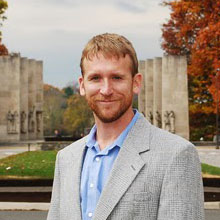



Oregon State University Libraries has been firmly committed to the long term preservation of the scholarship of the university and its unique digital assets as far back as 2008 when Terry Reese was appointed to an endowed position with responsibilities for building the digital preservation infrastructure of the Libraries. During his tenure, the Libraries began using LOCKSS for preserving journal content and joined the MetaArchive Cooperative as a sustaining member. Our digital preservation operations were vastly improved after 2012 with the hire of Brian Davis as Digital Production Unit Head , who developed format-specific identification, validation, characterization, and fixity checking of digitized content. The Libraries further committed to digital preservation in a 2012-2017 strategic plan that called for the creation of a “robust and flexible digital preservation and curation infrastructure” and “a long-term preservation system for university scholarship and digital collections developed and curated by OSU Libraries and Press.”
Brian and I presented a report to library leadership in 2017 that described the current state of the library’s digital preservation efforts and recommended next steps for preserving the Libraries digital objects. Emblematic of how quickly things are changing in the digital preservation space, many of the report recommendations have shifted over the last couple of years, but I am thrilled to say that some of the recommendations, in particular upgrading the library’s backup and storage systems to include monthly and incremental daily backups and the increased use of Archivematica for processing digital objects before repository ingest.
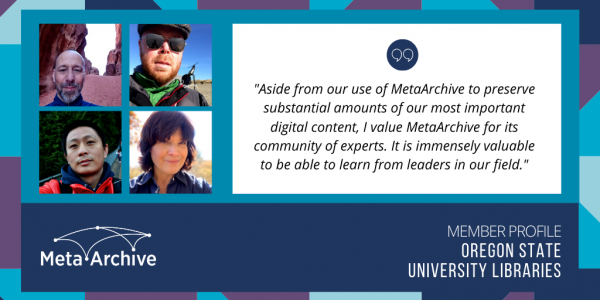
As noted, for digitized objects, a breadth of preservation work is done to ensure content validation and fixity for digitized objects. The master, preservation-level files are then moved onto ZFS storage systems via a BagIt protocol. For born-digital scholarship housed in the Samvera/Fedora based ScholarsArchive@OSU institutional repository, file integrity using a checksum tool is checked as part of file ingestion. Dr. Hui Zhang, digital services librarian, uses a script that traverses the hierarchy of repository objects in the institutional repository to locate and export binary files with the RDF metadata from specific repository collections. The generated BAGs are then moved to temporary Amazon Web Services storage for MetaArchive harvesting.
The Libraries first used MetaArchive to replicate the university’s corpus of Electronic Theses and Dissertations. Theses and dissertations represent the breadth of significant research and scholarship conducted at the university over its entire history, and also serve as an important historical record of the OSU research and teaching interests. MetaArchive is also used to replicate all of the University’s Extension and Experiment Station Communication Publications (EESC). As noted in this editorial from the Corvallis Gazette-Times, published after the EESC collection of over 6,000 technical reports were digitized and made available in the IR, many of the same issues that were important to Oregon residents 100 years ago continue to be important today. Preserving this content with MetaArchive’s robust Private LOCKSS network helps to ensure that it will be available to citizens today and long into the future.
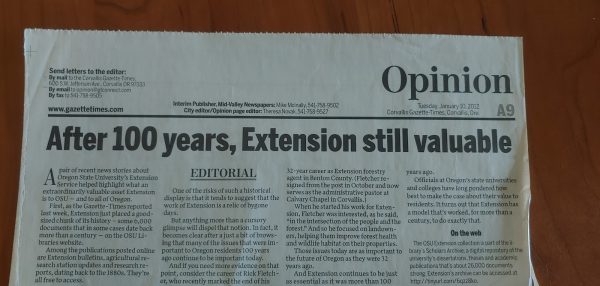
I have personally served as OSU’s representative on the MetaArchive Steering Team since 2015 and as this year’s Chair of the Steering Team. When I joined the Steering Team five years ago, I had a strong interest in digital preservation, but I had very little idea about how to do it. As noted above, OSU Libraries has invested in staff and resources to improve digital preservation operations, but this work should not be done in a vacuum. Aside from our use of MetaArchive to preserve substantial amounts of our most important digital content, I value MetaArchive for its community of experts. It is immensely valuable to be able to learn from leaders in our field such as Katherine Skinner, Matt Schultz, and Sam Meister (former MetaArchive Community Manager), and to learn from colleagues from a variety of different library and museum types about their preservation work.
As Katherine Skinner (Executive Director of Educopia) noted to members last year, MetaArchive, as the world’s longest tenured distributed digital preservation solution in the world, has been in place and operating within the same technology base and governance structure since its inception. As part of this Series, our community has had an opportunity to hear from experts in the field about alternative technological approaches. It has been invaluable to me to learn from experts in the field, and MetaArchive’s own experts like Nathan Tallman (Penn State) and Zach Vowell (Cal State Poly), that there are alternative solutions that are ripe for further exploration by the community. Another key takeaway for me is that MetaArchive will remain viable as a preservation network only so long as we are prepared to transition to meet the needs of the community. Fortunately, the transparency of the network and its governance structure helps to ensure that the community’s needs will continue to be met.
Editorial note: “Since late 2019 the MetaArchive community has been undergoing a series of intensive evaluations of both their organizational model as well as their technical approaches to distributed digital preservation (DDP). This is the Changing for Continued Impact (CFCI) Series, a facilitated framework led by Educopia that engages the MetaArchive members in a series of focused-discussions and work-sessions. This generative and co-creative process got underway in earnest this past Fall 2019, and will continue through Spring 2020 leading up to the next Annual MetaArchive Membership Meeting.”

Virginia Tech University Libraries was a founding member of the MetaArchive Cooperative and has hosted a LOCKSS cache since 2007. Our preservation system has evolved since then, including the addition of a second distributed digital preservation service with APTrust, the hiring of two digital preservation faculty members in 2017, and the ongoing development of a preservation-centric Digital Library Platform. The preservation system is managed by the Director of Digital Imaging and Preservation Services, the Digital Preservation Coordinator, and the Digital Preservation Technologist, and it is implemented by the Digital Library Development team in the Library. This group is responsible for developing and maintaining policies, overseeing workflows, and collaborating with our content producers. We are currently working on our Digital Preservation Program Priorities and Deliverables, outlining policies, services, and automations to be integrated with our new platform in development.
We have recently received a grant to digitize the Virginia Tech Insect Collection in 3D using photogrammetry in collaboration with the Entomology Department. 3D objects are complex and dynamic objects that present a preservation challenge, and we are investigating how our preservation workflow for these objects will differ from workflows for simpler objects. We are also developing a more robust Digital Humanities support system in the Libraries and are collaborating with VT Publishing to develop preservation levels for the variety of DH projects we hope to host. Ultimately, we are excited to have an automated preservation system built into the Digital Library Platform that communicates directly with MetaArchive.
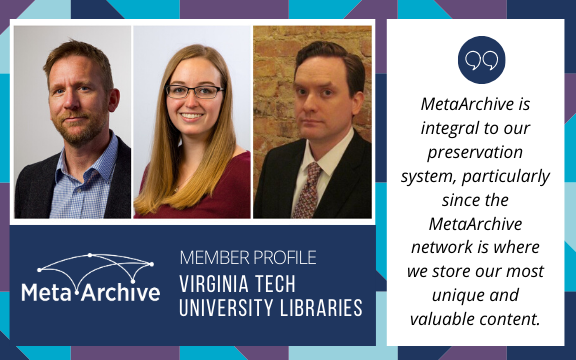
Our current workflows are under revision as our new Digital Library Platform is in its beta form. In the past we performed our MetaArchive ingests manually; we are working on a MetaArchive Automation Service to better streamline our preservation system. MetaArchive currently holds all of our digitized bound theses and dissertations prior to 2017. While we have not ingested content into MetaArchive during our preservation system development, we have maintained an active role in hosting our cache and staying active within the community.
Virginia Tech University Libraries has been an active member in MetaArchive since 2004, both as a cache host and in the community, including Steering Committee participation, and committee participation. The Change for Continued Impact Series has enabled us to engage more in the community and offer feedback. We have often relied on this community for advice or discussion in making our preservation decisions. MetaArchive is integral to our preservation system, particularly since the MetaArchive network is where we store our most unique and valuable content.
We have been active in the Changed for Continued Impact Series, and appreciate the expanded interest in community needs and comprehensive engagement. One of the most valuable outcomes thus far has been the MetaArchive-LOCKSS Sustainability Evaluations provided by Penn State and Cal Poly, as they are in line with our needs at Virginia Tech as we develop an automated system.
Editorial note: “Since late 2019 the MetaArchive community has been undergoing a series of intensive evaluations of both their organizational model as well as their technical approaches to distributed digital preservation (DDP). This is the Changing for Continued Impact (CFCI) Series, a facilitated framework led by Educopia that engages the MetaArchive members in a series of focused-discussions and work-sessions. This generative and co-creative process got underway in earnest this past Fall 2019, and will continue through Spring 2020 leading up to the next Annual MetaArchive Membership Meeting.”

Our colleague, Rare Books Curator Delinda Buie, happened to be in the right place at the right time when Martin Halbert and others discussed applying for an NDIIPP (National Digital Information Infrastructure and Preservation Program) grant to explore distributed digital preservation at an ARL (Association of Research Libraries) meeting in 2003. At the time, UofL did not have a formal digitization program, but the Special Collections department, in which Delinda worked, had been doing ad hoc digitization for customer orders and exhibits for several years. The successful NDIIPP grant evolved into the MetaArchive Cooperative, and locally led to the creation of the Digital Initiatives program, in which Rachel Howard has served since 2006 and has overseen Digital Collections of cultural heritage materials and an institutional repository of university scholarship. UofL’s digital preservation efforts focused on digitized images and oral histories. In 2017, after Kyna Herzinger had joined the team, UofL took steps to develop a framework for a digital preservation program, drafting policies, exploring tools, and documenting workflows. At that time, UofL’s digital preservation expanded to include born-digital university records, oral histories, and community collections.
In terms of content, we are looking forward to preserving our electronic theses and dissertations, which are currently backed up in the cloud. We plan to establish a workflow to have them harvested into the MetaArchive network. In terms of maturing our overall program, we have identified two areas of focus. Having no single position that is responsible for handling born-digital content, we are still ensuring that our curators can accession and process their own born-digital collections. This means fine-tuning workflows. We are also starting to shift focus toward improving access to born-digital content, both in terms of discovery and researcher support.
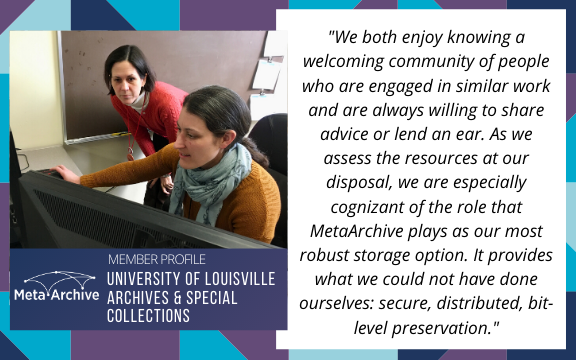
For digitized content, after creating master and access files and metadata and launching a digital collection to the public, Rachel would copy master files and an XML file of the metadata to a staging server and organize them into archival units (AUs) of acceptable size for ingest into the MetaArchive network. The size of those AUs grew over time as we tested network capabilities, so that, for example, our yearbooks, whose master files ballooned to as much as 50 GB per yearbook, could each be treated as a single AU, thus requiring less “data wrangling”. She would then create a manifest page and (as was required in the early days) plugin, document the locations of those files and the AUs in the MetaArchive Conspectus database, and then work with MetaArchive partners to test and then ingest the collection into the preservation storage network.
Now, with born-digital content, we use the BagIt profile specification, and recently participated in the MetaArchive’s SuperNode Pilot project, testing Bagit + OwnCloud and Exactly + SFTP to ingest content into the network.
We both enjoy knowing a welcoming community of people who are engaged in similar work and are always willing to share advice or lend an ear. Working together with this group has also provided us with opportunities for research and professional leadership/ service at an international level. As we assess the resources at our disposal, we are especially cognizant of the role that the MetaArchive plays as our most robust storage option. It provides what we could not have done ourselves: secure, distributed, bit-level preservation.
It has been reenergizing to connect in a more focused way with the partners as we talk about the past, present, and future of the Cooperative. The series has provided reassurance that growing pains are normal, that challenges are opportunities for growth, and that it is better to be proactive about change than to wait until circumstances demand an immediate reaction.We appreciate being part of a community in which we have a say in its future.
Editorial note: “Since late 2019 the MetaArchive community has been undergoing a series of intensive evaluations of both their organizational model as well as their technical approaches to distributed digital preservation (DDP). This is the Changing for Continued Impact (CFCI) Series, a facilitated framework led by Educopia that engages the MetaArchive members in a series of focused-discussions and work-sessions. This generative and co-creative process got underway in earnest this past Fall 2019, and will continue through Spring 2020 leading up to the next Annual MetaArchive Membership Meeting.”

The Digital Indy project has been a member of InDiPres since 2017, previous to this there had been concerns about the integrity and longevity of the digital archival collections being created by the project and an analysis found that the level of preservation and cost associated with InDiPres was the best available. The primary work of preparing and transferring digital collections to the InDiPres server is done as part of the role of the Metadata Specialist, as well as communication with the InDiPres and MetaArchive groups. I regularly attend and participate at meetings of these organizations and report back developments to the team at the library. As far as goals and visions for our involvement with this project I would be very pleased if we are able to preserve 100% of our large digital collections in the MetaArchive network by 2021. I would also like to see the ongoing Supernode efforts materialize into an efficient streamlined ingest system that would attract new members to InDiPres and MetaArchive.
We are presently working on getting more of our collections data ingested into MetaArchive as well as setting up firm and effective workflows for sending data to the InDiPres staging server after some technical issues have placed this on hold. I am excited to see how this will be made more efficient by some of the projects being worked on at MetaArchive.
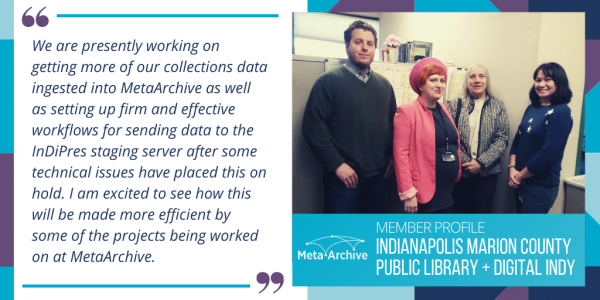
Our team has not had to significantly alter the established workflows in the initial areas of organizing and describing collections. The current standards we use are sufficiently robust as to create results that are effective for preservation purposes. We have had to make some additions to the workflows for successful ingest. This has involved processing collections through data integrity programs like Bagger and Exactly, setting up online transfer protocols, and creating documentation for preservation status of collections.
I have had a positive experience meeting and working with the MetaArchive community in the several years of my involvement with the organization. I have found the membership to be very informed about both their own digital preservation situation and the state of this field of expertise in general. It has been useful and beneficial to have a group of individuals facing similar challenges to share ideas and solutions with.
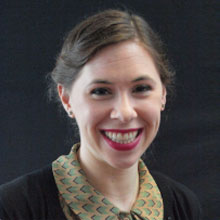
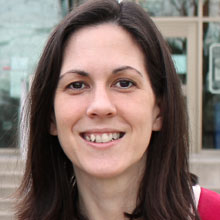

The collections we ingest into MetaArchive largely include born-digital objects and digitized copies of audio/visual recordings, and these kinds of collections are at risk for all sorts of loss and damage. MetaArchive provides a trusted way to preserve these at-risk digital collections in a long-term fashion. The trust stems from the fact that MetaArchive is composed of peer, cultural heritage institutions that are on the same wavelength, and that we have a voice on the way the organization is run. This all gives us peace of mind.
~ Zach Vowell, California Polytechnic State University